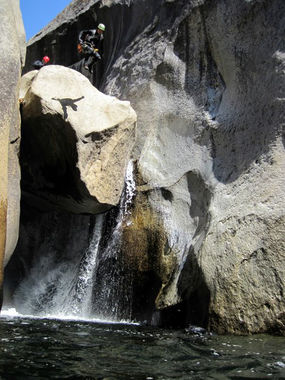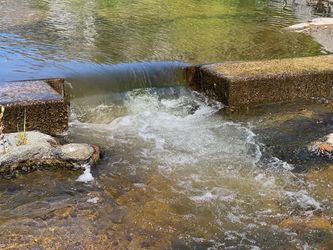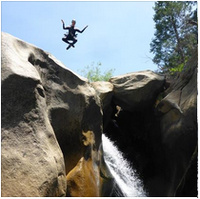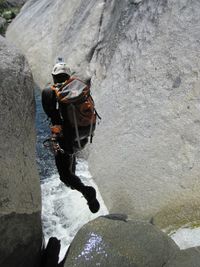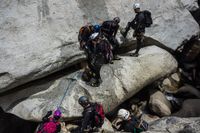Jump Trip (Upper)
| Rating: | |||||||||||||||||||||||||||||||
|---|---|---|---|---|---|---|---|---|---|---|---|---|---|---|---|---|---|---|---|---|---|---|---|---|---|---|---|---|---|---|---|
| | Raps:3, max ↨40ft
Red Tape:No permit required Shuttle:Required 10min or 2mi | ||||||||||||||||||||||||||||||
| Location: | |||||||||||||||||||||||||||||||
| Shuttle: | |||||||||||||||||||||||||||||||
| Condition Reports: | 6 Jul 2025
"Great conditions. Enough flow to be fun with a few present but easily avoidable water hazards. Most of us did just one rappel. Water still plenty cold |
||||||||||||||||||||||||||||||
| Best season: | Jul-Oct (avg for this region)
|
||||||||||||||||||||||||||||||
| Regions: | |||||||||||||||||||||||||||||||
Introduction[edit]
Shorter and smaller than its down stream brother Lower Jump Trip, Upper Jump Trip is still a trip to be taken seriously. Some technical obstacles may be more difficult than those in Lower Jump Trip depending on conditions.
Approach[edit]
Drop a shuttle vehicle at the exit parking lot. This parking lot can be harder to identify in person than it might seem from Google Earth; ensure that you have located the correct area by making sure there is a green gate blocking a dirt road to the south of the paved road. There will be another dirt road on the north side of the paved road. (If Black Rock campground is full, this other dirt road goes back 1/2 mile to a nice private camping area).
After leaving the takeout vehicle, drive back up the paved road 1 mile and take the exit for Blackrock campground. About 1/4 mile before the campground there is a spur road steeply descending to the right (south), along with a wooden signbox. Park here and hike down the spur road 200 yards to large flat areas on the right and left. Just below the flat area on the right is another dirt road leading off to the right. Hike down this road for 5 minutes to some large flat granite slabs at the river and put wetsuits on here.
Descent[edit]
Proceed down stream. One person in the group should verify water depth before each jump as conditions can change drastically. In many cases, it may be difficult to construct an anchor for the last person. But, if the last person is able to jump, they can meat anchor the rest of the group. The number of rappels and longest rappel length are based on an average group jumping often. It is possible to do the entire trip without rope if no pools are checked for depth, but this is not advised. If unwilling to make large jumps, these requirements may vary substantially. Under typical conditions, these are some of the obstacles that will be encountered:
- Jump rock: There is a small 6ft jump into the large pool when heading down stream. If you are able to exit the pool on its RDC side, you can climb up onto the very large boulder and make a 25ft jump into the pool (carefully avoiding the submerged rocks near the landing area).
- Climb/jump: It is possible to down climb RDC (choosing a path where slipping would result in sliding into the water), or there is a clean jump just RDC from the large boulder. The jump from the large boulder at center is also clean. Once at the base of the jump it is worth swimming behind the waterfall (if flow is safe) to enter a neat hidden pothole arch room. After this point, there is a long section of canyon without major features before the canyon picks back up at the Wall slide.
- Wall slide: The inclined slab may be downclimbed just RDC of the large boulder. Or, you can climb about 70ft past the broad RDC shelf (250ft past the downclimb point) and jump 36ft into the water from a dry, hanging pothole. If you downclimb the slab be sure to swim under the large boulder for an interesting waterfall room. A downclimb with a tiny hydraulic follows the wall slide, but is bypassed by the alternate jump.
- Ball jump: From a round boulder RDC, make a small jump into a narrow channel below.
- Awkward rappel: Slide down the face of a large boulder being careful not to fall forward off the landing zone. Rappel 15' from an anchor underneath the boulder you slid down, or climb up the boulder opposite that one and jump 22ft to a small landing zone.
- Chute rappel: A single button head bolt RDC is meant to anchor a handline to the edge of a 12' jump from a hanging pothole, but could also be used to rappel to the water to check depth
- Big jump: Possibly the best jump location in the canyon; jump 27ft from the large boulder chockstone, or rappel under the boulder from an awkward start through a hole behind (up canyon of) the boulder. The chockstone anchor can also be used to rappel LDC in low flow for members of the party not wishing to jump. The pull from here would be impossible though. Flow conditions may necessitate meat anchoring and rappelling in the jump line to check depth as the hydraulics at the bottom of the falls can be difficult to escape. This is where the cover photo for this canyon was taken.
- Slot traverse: Either chimney a slot with moderate to large fall penalty LDC, or rappel on a sling into the beginning of this slot. There are also bolts at the very top ridge of the rock to rappel RDC.
- Magical chamber: Climb up RDC to two bolts and rappel 10' into a pothole. Continue on rope down canyon through the slot to a rappel, 37' from anchors. Be careful of retrieval issues. Historically, there was a magical chamber at this location, but it has been filled in with debris. See the history of this page for more information.
- The bolt anchoring the 10' rappel into the pothole was originally placed to belay a climber going up to a ledge above, where you can walk 100' down canyon and jump, so that is a second option.
- Floating rappel: Jump from a large boulder (NOTE: there is a submerged boulder out about 5 feet, so jump very close to the large boulder wall). The meat anchor for the canyoneer rappelling to check depth may need to be floating during times of high flow.
- A few more 5-10' jumps spaced about 100 yards apart finish off the canyon. (NOTE: Where are these jumps??? Only one more short slide)
Water flow[edit]
Safe water flow is 12 cfs or less. Expert groups have descended the Upper Jump Trip as high as 13-14 cfs, but experienced considerable difficulty.
Gauge readings from the sensor in between Upper Jump Trip and Lower Jump Trip may be found at Dreamflows.
See Red Tape below for more detailed information on the flows.
Exit[edit]
Watch RDC for a water gauge (a 25' high aluminum cylinder) and stairs, and a small dam. Do not exit on the stairs, but continue down canyon 100 yards to a large pool with slabs RDC. The exit RDC starts as a footpath next to the rusty smashed car, and shortly becomes a rough dirt road as it ascends. The exit hike is 540ft of elevation gain, taking about 20 minutes.
Red tape[edit]
Pacific Gas and Electric operates the Blackrock dam and periodically releases extremely large flows. While the typical safe flow rate is 13 CFS or less, during spring runoff the canyon has flowed at over 6000 CFS. Ensure that you are not in the canyon when a release occurs.
In 2009 PG&E converted to an automatic power management system for the underground Hass powerhouse. What this means is if power demands exceed Hass's generating capacity, one or two auxiliary generators will automatically spool up, ramping up to 800cfs each over the course of several minutes. This release is captured and stored in the Black Rock reservoir. This is usually not a hazard for the canyon, unless the reservoir is full to the brim of water, in which case the excess water will spill over the top of the dam into the canyon. To be on the safe side, always check the level of water at the Black Rock reservoir dam, and use extreme caution if the water level is at the brink of the dam.
In addition to this, occasionally there are maintenance releases from valves at the bottom of the dam, but these are usually in the spring time and usually occur during weekdays.
It may be possible to drive to the PGE Balch Camp HQ and/or call them at 559-487-6275 to confirm dam release plans. They also have free wifi at the Balch Camp HQ.
Beta sites[edit]
Trip reports and media[edit]
July 16, 2019
Background[edit]
Paul M: Greg Smith had listened to my Jump Trip stories for awhile and asked if he could bring his high school outdoor adventure club down the canyon. I thought the lower section would be too much. I had not looked carefully at the upper except for swimming upstream a ways and looking down into it from a few spots. I had the foolish impression that it was mostly flat and so suggested we bring the novice kiddies there. A date was set, the troupe showed up and I blindly led them down the canyon. We avoided all the nice jumps with rope work till we got to the little 12 foot jump into a slot with an alcove on the right. At that point reality started to set in. We realized this drop was not reversible and we realized that the canyon was much more serious than a bit of swimming and down climbing. We turned around and returned back up canyon. I managed to find fairly reasonable climbing routes and belayed the others up the tricky spots. We were disappointed but it was a pretty big adventure even as far as we got.
Greg was still interested in seeing the whole canyon and I had to see what I had been ignoring. I returned a week or two later and hiked down from the heliport behind the cabin at the road junction. John Scow who was the school teacher in Balch Camp at the time showed me this approach. I brought a couple ropes and a bolt kit, not knowing what I might find. Being solo, I must have been a little fired up. I never broke out the ropes or bolt kit at all, so the upper jump has a tradition of going ropeless. However conditions change and a couple spots that I was able to climb are no longer easily climbable. At the sideways traverse (below Big Jump), I climbed up on top of the boulder, shinnied along, then slid down on the right side. At that point there is the tall boulder close to the right wall. On that first trip and for a number of years there was a smaller boulder next to it which provided easy access to the top of the tall boulder. From the top of the tall boulder it was a fairly easy jump to the ledge on the right wall. The ledge slopes steadily downward till there is good jumping potential into a narrow pool. I could not see the landing very well, so continued on past a very narrow and delicate balancing spot on the ledge, till it was quite low and more obviously safe to jump. That trip took 45 minutes. Something about being solo, fired up and used to that sort of thing.
I reported back to Greg that the trip seemed doable and he brought his high school students back, though I think the next year. We placed a couple bolts here and there to lower the kids. No significant jumping was allowed. They made an annual event of it though and for many years it was the highlight trip of the outdoor club at a private high school in San Rafael.
In the years since, other parties have added a number of bolted anchors along the route. Depending on conditions and experience level, the trip can be done without breaking out a rope.
